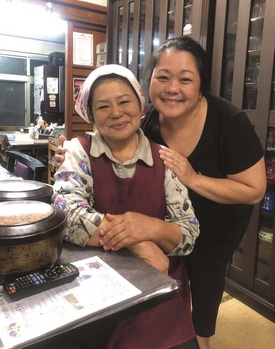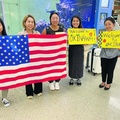Did you know there are mules on Izenajima (Izena Island)? Well, recently there were two roaming around there.
My Leilehua High School friend, Valdeane Odachi, and I were in a concert band together. We haven’t seen each other since I graduated, but got reconnected via Facebook several years ago. One of the dining establishments I frequent is Yoshihachi Sushi Restaurant in Chatan so I often post pictures of my outings there to highlight the delicious menu but also recognize my longtime friendship with owner and chef, Yoshio Maekawa. Valdeane saw my posts and commented that she thought the guy in my pictures is her relative.
On another visit, I asked Yoshio if he was related to my fellow Mighty Mule friend, and he immediately replied about the relationship and his one-year stay in Wahiawā in the early 1970s. I told Valdeane about it who also confirmed that they were related through her maternal great-grandmother who was sisters with Yoshio’s grandmother. I then strongly encouraged her to come to Okinawa to meet her relatives and experience the culture because she never came here before.

Last October Valdeane contacted me to tell me that she finally made plans to visit Okinawa and that she would be accompanied by her sister-in-law, Judy Odachi. From there, we kept in touch via email and Facetime video chats as I inquired with Yoshio if there were any relatives still living on Izenajima, the birthplace of King Shō En – first king of the 2nd Shō Dynasty who reigned during the 15th Century, because Valdeane’s desire was to go there and meet them. He replied that there is a relative, Kiyoshi Maekawa, who runs a minshuku (guest house) with his wife, Fumiko, and put me in touch with them.
I contacted Kiyoshi to introduce myself and explained Valdeane’s plans to journey to her roots followed by making reservations for the three of us to stay with them. I also asked Kiyoshi if he could take us to hakamairi (grave visitation) and show us around the island inhabited by 1,136 people in 736 households (data as of Sept. 30, 2022), which he gladly obliged.
After spending some time on mainland Japan, Valdeane continued with her tour group and set foot on Okinawa for the first time on Friday, March 24. Instead of going back with them, however, she and Judy extended their trip by a few days in order to make the trek to Izenajima.
I picked them up from their hotel in Naha and then took a scenic two-hour and 52-mile drive on back up to Untenkō (Unten Port) in Nakijin Village. I wanted to allow some cushion time to locate the port, purchase ferry tickets and find overnight parking for my car as it was over 16 years since my first and only visit to Izenajima with my church pastor and his family.
There are only two daily round trip runs between Untenkō and Izenajima so I told Valdeane we should board the morning ferry at 10:30 a.m. to allow more time to spend time with family and tour the other end. After sitting in the ferry terminal with our overnight bags, we watched the ferry pull in and got up to walk along the pier and board.
Once aboard, Valdeane and I headed outside to enjoy the breeze and scenery of Kourijima (Kouri Island) and the Higashi Shina Kai (East China Sea). As we continued to catch up on stories from the past 34 years, we went back into the passenger cabin to relax for a little while and came back outside just before the ferry pulled into Izenakō (Izena Port). We were first greeted by the large iconic sign “Yōkoso, Habu No Inai Izenajima” (Welcome to Izena, the island of no habu) on the terminal followed by the smile of Kiyoshi who was waiting for us as we disembarked.
Kiyoshi drove us to Minshuku Maekawa, less than half a mile away where Valdeane exchanged introductory greetings and hugs with Fumiko. We dropped off our bags then headed back to the house where they had prepared lunch for us. While eating, Valdeane had the opportunity to ask questions about her Maekawa relatives and ancestors from Izenajima.
It was a touching moment to see tears flow from Valdeane’s face as she learned that her great-grandmother was a high priestess and well revered in the community. “Setting foot on Izena, learning about my family, and stepping into the ocean waters that my ancestors bathed in provided me with a deep comfort, finally understanding the Hawaiian concept of ‘one hānau,’” or sense of place, which is often translated as ‘sands of birth’ or where one originates from.
Kiyoshi then took us on a tour of the island, first stopping at a nearby home to meet an aunty who was one year short of being a centurion. The connection with relatives and roots solidified more as Valdeane learned about her Uchinānchu background with each piece of information shared such as stopping by the former residence of her great-grandmother followed by a hakamairi visit to two tombs.
Our tour around the island continued with a stop at Izena Tamaudun, one of three Ryūkyū Kingdom royal mausoleums, followed by another stop at Gitara Tenbōdai (observatory) on the south side of Izenajima overlooking Higashi Shina Kai and a small island whose only inhabitants are hïjā (goats). Further stops included a port with a mozuku (Okinawan seaweed) farm and Izena Beach before continuing on to view sugar cane fields, rice paddies, a desalinization plant, and the elementary and junior high schools. Since no high school exists on Izenajima, students must move to Okinawa main island to continue their education.
Upon returning to the minshuku, we took a one-hour break to freshen up before joining other guests, three construction contractors sent there to build the new school and a family visiting their daughter whose ambition was to work on the mozuku farm on Izenajima after graduating from high school, in a friendly dining setting. Valdeane continued the conversation with her relatives to find out more about her Maekawa roots before we retired to our rooms for the evening.
After a hearty breakfast the next morning, we loaded our bags into their minivan and Fumiko took us on a quick tour of the birthplace of Shō En in Mihosojo, a monument of him pointing eastward to Okinawa main island in Shō En Ō Oniwa Kōen, and another monument depicting him in his younger years looking backwards on horseback as he leaves the lover he courted.
The stops at those sites were pretty brief as we needed to get to the port to board the ferry for our 9 a.m. departure back to Okinawa main island. Before we boarded, Kiyoshi handed us several rolls of streamers in a rainbow of colors and told us to hold the ends of each roll and to throw them overboard to them standing on the pier as it is traditional for island residents to send off visitors this way. I happened to choose two rolls of green and yellow, the color of Valdeane’s and my alma mater.
Fumiko invited the family staying at the minshuku to see us off so we watched as the rolls unfurled and the couple’s daughters chased the opposite end all over the pier and grabbed hold of the other end. Valdeane and her sister-in-law saved the streamers as reminders of Valdeane’s memorable connection with Izenajima relatives.
Once we were back at Untenkō, we headed for Yomitan where we spent some time at my house and I was able to introduce Valdeane to my wife, Keiko. We chatted for a bit and then headed for Yoshihachi Sushi Restaurant to meet Yoshio, his older brother Yoshimasa Maekawa, and another aunty, Kiyo Maekawa, who was a former representative for Kadena-chō (town) and kyūdō (Japanese archery) practitioner that represented Okinawa prefecture in 10 national competitions. We ended the time taking a picture that I’ve been waiting for years to capture – Valdeane with Yoshio in his well-known pose with replica samurai sword drawn overhead.
Although it’s been years since I started to encourage Valdeane to come out this way and connect with family, her journey to dig into her Uchinānchu identity and roots has just begun.
“Meeting family and learning about my indigenous culture was like returning home, but to a home I had never seen before. Aunty Kiyo shared so much about my great-grandmother and extended family, answered questions I longed to have answered, and shared stories I had never heard. This journey helped heal the many parts of me that felt disconnected and lacking in identity. Learning about the shared cultural beliefs and practices of those on Izenajima and the islands of Hawai‘i was a bonus. I can’t wait to return, but this time, with my daughter and son.”
*This article was originally published in The Hawai‘i Herald on June 16, 2023.
© 2023 Colin Y. Sewake / The Hawaii Herald




